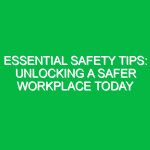Introduction
Hello team, and thank you for being here today. As we gather for this toolbox talk, I want to address a serious topic that affects us all: workplace suicide. It’s crucial to understand that mental health is just as important as physical Safety in our work Environment. Today, we will explore effective strategies to promote mental well-being, recognize warning signs, and foster a supportive workplace culture that can help prevent suicide. Let’s dive in.
The Importance of Addressing Workplace Suicide
Suicide is a leading cause of death worldwide, and the workplace can often be a significant stressor contributing to mental health challenges. According to the World Health Organization, approximately 800,000 people die by suicide each year, and many more attempt it. Within our industry, the pressures of deadlines, physical labor, and the inherent risks of our jobs can exacerbate mental health issues.
Addressing workplace suicide isn’t just about compliance with health and Safety Regulations; it’s about creating a culture where every employee feels valued, supported, and safe. A proactive approach can lead to increased productivity, reduced absenteeism, and a more cohesive team environment.
Recognizing the Signs of Distress
Understanding the signs that someone may be struggling with suicidal thoughts is vital. Here are some indicators to watch for:
- Changes in behavior: A noticeable shift in someone’s typical behavior, such as increased irritability, withdrawal from colleagues, or sudden changes in work performance.
- Emotional distress: Frequent expressions of hopelessness, anxiety, or overwhelming sadness.
- Physical signs: Neglecting personal hygiene or significant changes in sleep and appetite can be red flags.
- Talking about suicide: Direct or indirect comments about wanting to die or feeling worthless should always be taken seriously.
If you notice these signs in a co-worker or even in yourself, it’s essential to take action. Remember, early intervention can save lives.
Creating a Supportive Workplace Culture
So, how can we foster an environment that prioritizes mental health and reduces the risk of workplace suicide? Here are some practical strategies:
- Open communication: Encourage employees to express their feelings and concerns without fear of judgment. Regular check-ins can help create a supportive atmosphere.
- Training and awareness: Participate in mental health first aid Training and educate employees about recognizing signs of distress and how to provide support.
- Support systems: Implement employee assistance programs (EAPs) that provide confidential counseling and support services. Ensure everyone knows how to access these resources.
- Promote work-life balance: Encourage employees to take breaks, use their vacation time, and engage in activities that promote relaxation and well-being.
Best Practices for Preventing Workplace Suicide
Let’s discuss some Best Practices that you can incorporate into your daily routines to help prevent workplace suicide:
- Stay informed: Keep up to date with mental health resources and trainings offered by our company.
- Be proactive: If you notice a colleague struggling, reach out and offer your support or encourage them to seek help.
- Practice self-care: Make sure you are taking care of your mental health. Engage in activities that reduce stress, such as exercise, hobbies, or spending time with family and friends.
- Build strong relationships: Foster connections with your teammates. Strong relationships can provide support during difficult times.
Real-Life Scenarios and Discussions
To illustrate the importance of these practices, let’s consider a hypothetical scenario:
Imagine a colleague, Alex, who has recently become withdrawn and has missed several deadlines. You notice that Alex has been unusually quiet during meetings and seems to be struggling with tasks that were once easy for them. Instead of ignoring these signs, you decide to approach Alex during a break. You ask how they’re doing and if they’d like to talk about anything. This simple act of reaching out could open the door to a much-needed conversation.
Engaging with our colleagues is essential. Now, let’s open the floor for discussion. Can anyone share a time when they noticed a colleague in distress? How did you handle it, and what was the outcome?
Regulations and Standards
It’s important to recognize that there are regulations and standards in place regarding workplace mental health. For example, under the Occupational Safety and Health Administration (OSHA) guidelines, employers are required to provide a safe work environment, which includes addressing psychological Hazards.
By adhering to these regulations, we not only comply with legal obligations but also demonstrate our commitment to the well-being of our employees. This proactive stance can significantly reduce the risks associated with workplace suicide.
Conclusion
In conclusion, addressing workplace suicide is a shared responsibility that requires open communication, awareness, and proactive support systems. By recognizing the signs of distress, fostering a supportive culture, and implementing Best Practices, we can create a safer and healthier work environment for everyone.
Thank you all for your attention and commitment to this crucial issue. Remember, mental health matters, and we all play a role in supporting one another. If you have any questions or need further resources, please don’t hesitate to reach out.


